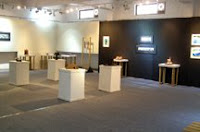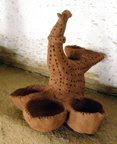Shampa Shah a renowned ceramic artist exhibited her works in Bharat Bhawan recently. Apart from freelancing as a studio potter she has also been working in The Indira Gandhi Manav Sangrahalaya, Bhopal
As you enter the gallery a little note beautifully expresses the mood of her work….She talks of how the trees and plants are not stagnant at one place they move and fly… they play with the flowing wind and seeds fly along with it to different places, how even if the leaves or flowers fall the new little delicate sprouts take their place in time….the spirit of these different things combined together gives life even to the lifeless objects…. In the outskirts of the villages you find a tree or a chabutra which is considered the devsthan and becomes a host to a group of horses, bulls or elephants kept as votive objects to please or thank the devtas. Shampa sees life within this cluster of haphazardly kept votive offerings, the fear, expectation or gratitude of the villager that these offerings represent, the tree or chabutra along with the terracotta offerings transforms themselves into a space which vibrates with life of their belief and the simplicity of it.
One sees a clear reflection of this in her forms. They are not just horses or forms inspired by votive objects …but in itself they complete the whole characteristics of everything that is around those votive objects. The sensitively handled delicate buds and plants curve and emerge through the body of the horse as if the foliage is growing from within. Each piece reflects a different body language a different expression and different movements of the foliage adding to the expression of the horse. As if the surroundings and the purpose of the place have brought life to the votive object.
After their purpose is complete these votive pieces are left to take care of themselves under the changing weather, their surface peeling, their color fading and moss giving it an even more dynamic look. The textures and the treatment of clay and her use of glazes and slips did full justice to the forms. The large drawings behind some of these forms gave them a physical space, a relation with the place they were displayed in. They didn’t look like forms picked up and put into a gallery which was foreign to them seeking attention of the viewer but were very much at home in their own space and letting the viewer quietly enter and share their world.
Photos Courtesy: Shanpa Shah
Article: Mudita Bhandari
Published: Indian Ceramic Quarterly, (issue 2/2009) Delhi Blue Pottery Trust

















































